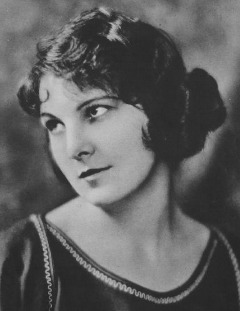Leatrice Joy (Leatrice Johanna Zeidler)

Leatrice Johanna Zeidler was born in New Orleans, Louisiana to dentist Edward Joseph Zeidler, who was of Austrian and French descent, and Mary Joy Crimens Zeidler, who was of German and Irish descent. She had a brother, Billy, who later worked at Metro-Goldwyn-Mayer. Leatrice Joy attended New Orleans Convent of the Sacred Heart but left when her father was diagnosed with tuberculosis and forced to give up his dental practice. She tried out for the New Orleans-based Nola Film Company in 1915 and was hired as an actress. Her mother disapproved of her becoming an actress, but the family needed the money, so her mother accompanied her to California where she began working in plays and films. Leatrice Joy began her acting career in stock theater companies and soon made her film debut; between April 1916 and November 1917 she was the star of about 20 one-reel Black Diamond Comedies produced by the United States Motion Picture Corporation in Wilkes-Barre, Pennsylvania, and released nationally by Paramount Pictures. In many of these, she starred as “Susie,” an irrepressibly enthusiastic, impulsive young woman who gets into humorous scrapes. In late 1917 she relocated to the relatively young film colony in Hollywood, California and began appearing in comedy shorts opposite Billy West and Oliver Hardy. Signed under contract with Samuel Goldwyn Studios, her first role for the studio was in 1917’s The Pride of the Clan opposite Mary Pickford. Her career quickly gained momentum, and by 1920 she had become a highly-popular actress with the filmgoing public and was given leading-lady status opposite such performers as Wallace Beery, Conrad Nagel, Nita Naldi, and Irene Rich.
Directors often cast Leatrice Joy in the “strong-willed independent woman” role, and the liberated atmosphere of the Jazz Age Roaring Twenties solidified her public popularity, especially with female film goers. Her close-cropped hair and somewhat boyish persona (she was often cast as a woman mistaken for a young man) became fashionable during the era. With her increasing popularity, Joy was sought out by Cecil B. DeMille, who signed her to Paramount Pictures in 1922, immediately casting her in that year’s successful high-society drama Saturday Night opposite Conrad Nagel. Joy starred in a number of successful releases for Paramount and was heavily promoted as one of DeMille’s most prominent protégées. In 1925, against the advice of studio executives, Joy parted ways with Paramount and followed DeMille to his new film company, Producers Distributing Corporation, for which she made a few moderately-successful films, including Lois Weber’s last silent film The Angel of Broadway in 1927. A professional dispute ended the DeMille/Joy partnership in 1928 and she was signed with MGM. That year she headlined MGM’s second part-talkie effort, The Bellamy Trial opposite Betty Bronson and Margaret Livingston. Joy’s career began to falter with the advent of talkies, possibly because her heavy southern accent was considered unfashionable in comparison with other actresses’ refined “mid-Atlantic” diction. In 1929 she became a freelance actress without a longterm contract. On May 13, 1985, Leatrice Joy died from acute anemia at the High Ridge House Christian Science nursing home in Riverdale, Bronx, New York. She was interred at the Saint Savior Episcopal Churchyard in Old Greenwich, Fairfield County, Connecticut.
Born
- November, 07, 1893
- New Orleans, Louisiana
Died
- May, 13, 1985
- Riverdale, Bronx, New York
Cause of Death
- acute anemia
Cemetery
- Saint Savior Episcopal Churchyard
- Old Greenwich, Connecticut


